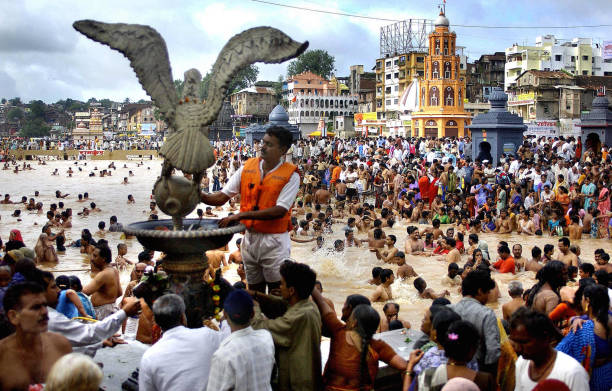
2027 Nashik Kumbh Mela – Official Dates Announced
The much-awaited Nashik Kumbh Mela 2027 is officially scheduled to begin on October 31, 2026, and will continue until July 2028. The Maharashtra Government announced the dates after a high-level meeting with spiritual leaders, including representatives from all 13 Akharas. For the first time, the Nashik Kumbh Mela will span 21 months, allowing better crowd management and enhanced pilgrim experience.
Key Dates for the 2027 Nashik Kumbh Mela
✅ Amrit Snan (Shahi Snan / Royal Bath) Dates
The sacred “Amrit Snan” (previously known as Shahi Snan) is the most significant ritual of the Kumbh Mela. The term was recommended by Mahant Rajendradas Maharaj and has been adopted officially.
| 📅 Date | 🛁 Amrit Snan | 🕉 Hindu Calendar Date |
|---|---|---|
| August 2, 2027 | 1st Amrit Snan | Ashadh Somvati Amavasya |
| August 11, 2027 | 2nd Amrit Snan | Shravan Amavasya |
| September 11, 2027 | 3rd Amrit Snan | Bhadrapada Shuddha Ekadashi |
Other Significant Dates
Apart from Amrit Snan, several other dates offer the opportunity for holy dips in the sacred Godavari River:
| 📅 Date | ✨ Occasion |
|---|---|
| July 24, 2027 | Flag Hoisting Ceremony (Kumbh Mela Commencement) |
| September 5, 2027 | Rishi Panchami |
| September 11, 2027 | Bhadrapada Shuddha Ekadashi |
| September 15, 2027 | Bhadrapada Purnima |
| October 11 & 15, 2027 | Ashwin Shuddha Ekadashi & Purnima |
| November 10 & 14, 2027 | Kartik Shuddha Ekadashi & Purnima |
| January 26, 2028 | Mauni Amavasya |
| February 1, 2028 | Vasant Panchami |
| February 8, 2028 | Ganga-Godavari Mahotsav |
| February 27, 2028 | Maha Shivratri |
| May 25 – June 2, 2028 | Ganga Dussehra Utsav |
Why This Kumbh Mela Will Be Longer
The extended duration of the 2027-2028 Kumbh Mela — lasting 21 months — is a strategic decision. Unlike Prayagraj (10,000 acres), Nashik has a limited area for pilgrim accommodation:
-
Sadhugram area: ~350 acres
-
Ramkund Ghat: ~100+ acres
By spreading the event over a longer period, crowds can be better managed, and devotees can plan their pilgrimage more conveniently.
🙏 Important Highlights of the 2027 Nashik Kumbh Mela
-
Participation from all 13 Akharas
-
Enhanced focus on cleaning and rejuvenating the Godavari River
-
Devotee zones being prepared in Tapovan, Panchvati, and Trimbakeshwar
-
Construction of an alternate ghat along the Godavari in Trimbakeshwar
-
A total of 3 Amrit Snans and 45 Kumbh Snan dates
🏕 Participating Akharas
The 2027 Kumbh Mela will witness participation from all major Akharas — spiritual institutions that represent centuries of yogic traditions and Hindu monastic orders:
-
Juna Akhara
-
Niranjani Akhara
-
Mahanirvani Akhara
-
Atal Akhara
-
Ahwan Akhara
-
Nirmohi Akhara
-
Anand Akhara
-
Panchagni Akhara
-
Nagpanthi Gorakhnath Akhara
-
Vaishnav Akhara
-
Udasin Panchayati Bada Akhara
-
Udasin Naya Akhara
-
Nirmal Panchayati Akhara
🏗 Infrastructure & Development Projects
To accommodate the spiritual and logistical needs of millions of pilgrims, the Maharashtra government has announced development projects worth ₹4,000 crore. Of this:
-
₹2,000 crore are already in the execution pipeline
-
Land will be cleared and allocated for Sadhus and Mahants
-
Enhanced sanitation, connectivity, water supply, and safety measures will be implemented
📌 Conclusion
The 2027 Nashik Kumbh Mela promises to be one of the most well-organized and spiritually enriching events in recent times. With 21 months of festivities, 3 Amrit Snan dates, and massive development plans, this Kumbh Mela is set to attract millions of devotees from across India and the world.
Some Important Questions During Nashik Kumbh Mela Tour
1. What is Kumbh Mela?
Kumbh Mela is one of the largest and most sacred religious gatherings in the world. Rooted deeply in Hindu mythology, it is a mass congregation of millions of devotees who come together to take a holy dip in a sacred river. The ritual symbolizes spiritual purification, believed to cleanse one’s sins and help attain moksha (liberation).
Held once every 12 years at one of four sacred locations—Prayagraj, Haridwar, Ujjain, and Nashik—Kumbh Mela is a powerful celebration of faith, devotion, and spiritual unity, drawing pilgrims, sadhus (holy men), and tourists from around the globe.
2. When is the Next Kumbh Mela in Nashik?
The upcoming Nashik Kumbh Mela is scheduled for 2027, with the tentative period between August and October. The exact dates depend on astrological alignments, specifically the positioning of Jupiter, the Sun, and the Moon in certain zodiac signs, which determine the most auspicious days for rituals like Shahi Snan (royal bath).
3. What Are the Four Locations of Kumbh Mela?
The Kumbh Mela rotates among four sacred riverbanks across India, each associated with a drop of the mythical nectar of immortality (Amrit) that fell during the celestial event known as the Samudra Manthan (Churning of the Ocean):
-
Prayagraj (Allahabad) – At the confluence of the Ganga, Yamuna, and Saraswati rivers
-
Haridwar – On the banks of the holy Ganges River
-
Ujjain – Along the Shipra River
-
Nashik – On the banks of the sacred Godavari River
4. Why is Kumbh Mela Celebrated?
Kumbh Mela is celebrated to commemorate the divine battle between gods and demons over a pitcher (kumbh) of Amrit, the nectar of immortality. According to Hindu mythology, during this battle, drops of the nectar fell at the four locations mentioned above, sanctifying them forever.
The timing of the Kumbh Mela is based on precise astrological calculations, especially the movement of Jupiter (Guru) and its alignment with other celestial bodies. These alignments are believed to create the most spiritually potent conditions for purification and enlightenment.
5. How to Reach Kumbh Mela in Nashik
Traveling to the Nashik Kumbh Mela is convenient via multiple modes of transportation:
-
By Air: The nearest airport is Nashik Airport (Ozar Airport), with connectivity to major Indian cities.
-
By Train: Nashik Road Railway Station is well-connected with trains from all parts of the country.
-
By Road: Nashik is accessible by national highways and state transport buses. During the Kumbh Mela, special shuttle and public transport services are arranged for pilgrims’ ease and safety.
6. When are the Kumbh Mela Dates?
The dates for each Kumbh Mela vary and are determined by astrological and lunar calculations. For the 2027 Nashik Kumbh Mela, the tentative window is August to October 2027, with the most important events being the Shahi Snan (Amrit Snan) dates — considered highly auspicious for bathing in the holy river.
7. Where is the Next Kumbh Mela Being Held?
The next Kumbh Mela will take place in Nashik, Maharashtra, in 2027. As one of the four sacred destinations of the Kumbh circuit, Nashik is uniquely revered for its spiritual energy, mythological significance, and the divine presence of the Godavari River. The city will host millions of devotees over the months-long celebration.
